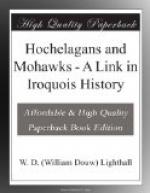All the country was covered with forests “except around the peoples, who cut it down to make their settlement and tillage.” At Stadacona he was shown five scalps of a race called Toudamans from the south, with whom they were constantly at war, and who had killed about 200 of their people at Massacre Island, Bic, in a cave, while they were on the way to Honguedo to fish. All these names must of course be given the old French pronunciation.
Proceeding up the river near Hochelaga he found “a great number of dwellings along the shore” inhabited by fisherfolk, as was the custom of the Huron-Iroquois in the summer season. The village called Hochelay was situated about forty-five miles above Stadacona, at the Richelieu rapid, between which and Hochelaga, a distance of about 135 miles, he mentions no village. This absence of settlements I attribute to the fact that the intermediate Three Rivers region was an ancient special appurtenance of the Algonquins, with whom the Hochelagans were to all appearance then on terms of friendly sufferance and trade, if not alliance. In later days the same region was uninhabited, on account of Iroquois incursions by the River Richelieu and Lake Champlain. In the islands at the head of Lake St. Peter, Cartier met five hunters who directed him to Hochelaga. “More than a thousand” persons, he says, received them with joy at Hochelaga. This expression of number however is not very definite. It is frequently used by Dante to signify a multitude in the Divina Comedia. The town of Hochelaga consisted of “about fifty houses, in length about fifty paces each at most, and twelve or fifteen paces wide,” made of bark on sapling frames in the manner of the Iroquois long houses. The round “fifties” are obviously approximate. The plan of the town given in Ramusio shows some forty-five fires, each serving some five families, but the interior division differs so greatly from that of early Huron and Iroquois houses, and from his phrase “fifty




